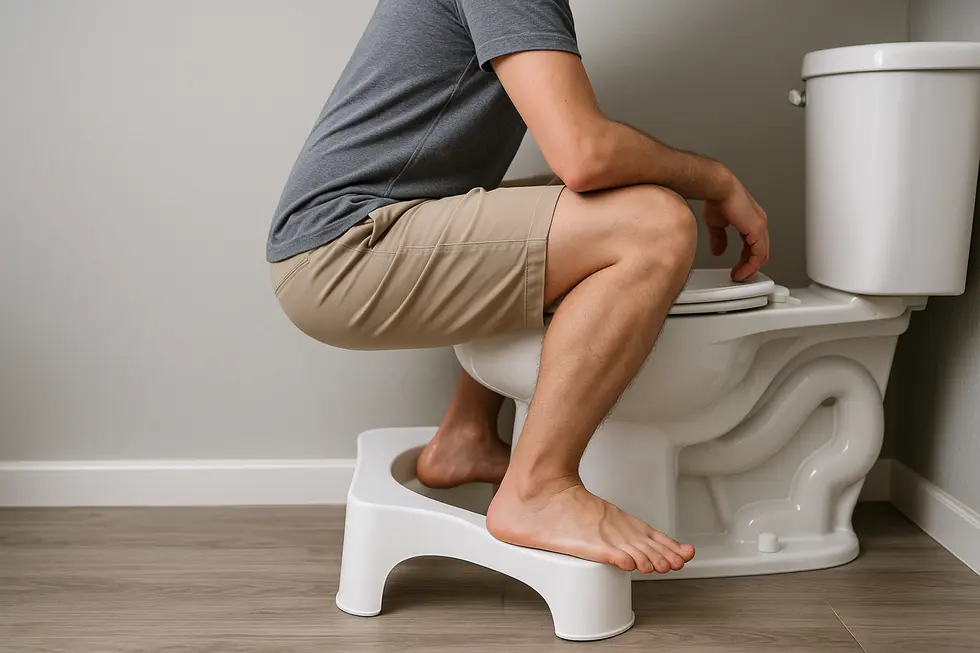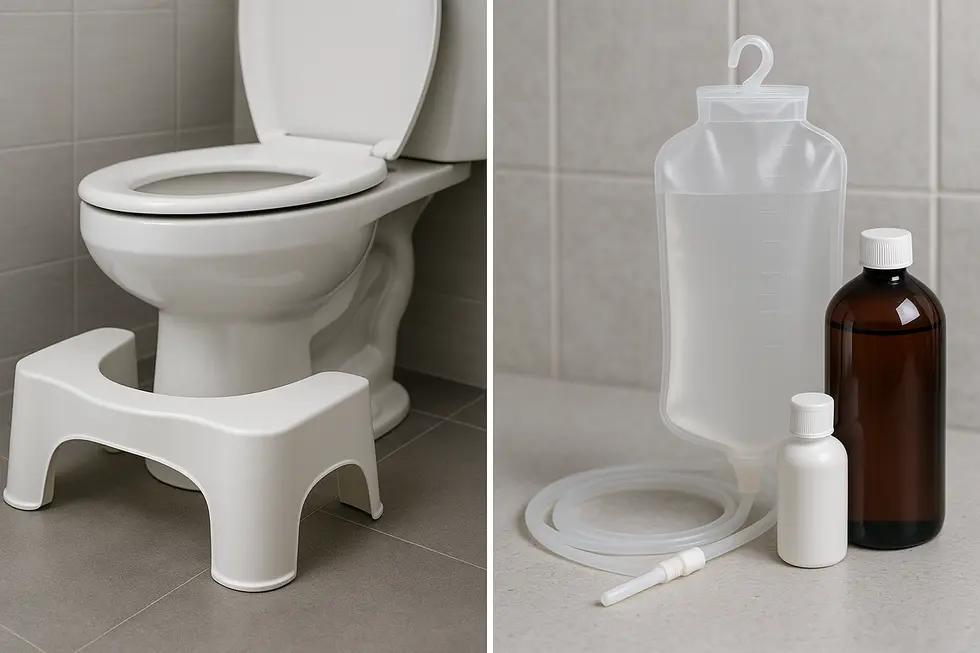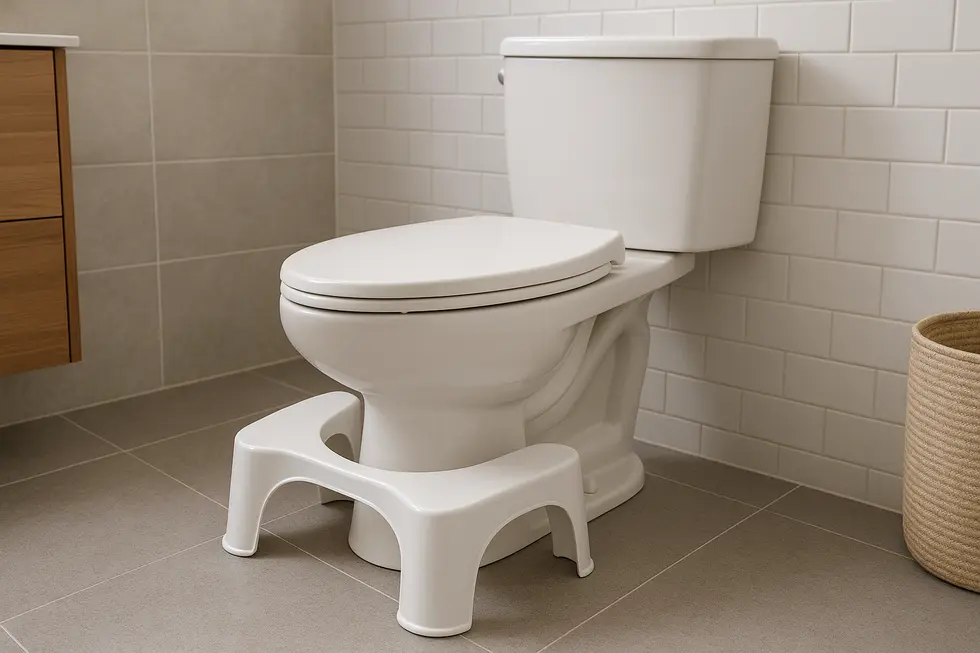Toilet Stools
Elevate Your Health: The Impact of Toilet Stools on Colon Wellness
Considering the simple yet effective role toilet stools play in promoting digestive health can transform your daily routine. By aligning the body in a natural squatting posture, individuals can foster better bowel movements and reduce digestive strain. This article delves into the biomechanical advantages, clinical evidence supporting hemorrhoid and constipation reduction, and compares toilet stool strategies with other cleansing tactics. Each chapter provides insight into how adopting this method can be a pivotal change to enhance colon health holistically.
Aligning the Rectum: How Squat Mechanics Transform Colon Health with a Simple Toilet Stool

Standing upright, the puborectalis muscle forms a sling that kinks the rectum to maintain continence. When we sit on a chair-height toilet that kink only partially relaxes, leaving the recto-anal canal at roughly 80° and forcing us to push against a bend. Elevating the feet on a toilet stool shifts the pelvis forward into a gentle squat, relaxing the sling and opening the anorectal angle to about 100–110°. That small geometric change is powerful: stool can now slide through a straighter channel rather than turning a corner, so less abdominal pressure is needed.
Lower pressure means lower risk. Straining spikes intra-abdominal force, which transmits directly to veins surrounding the anal cushions; over time this repetitive stress inflames tissue and seeds hemorrhoids. By allowing gravity to do more of the work, a squat-like posture cuts both the frequency and intensity of those spikes. Clinical imaging confirms users empty their bowels more completely and in roughly half the time, a pattern associated with fewer episodes of constipation, less residual stool fermentation, and therefore reduced bloating and gas.
Biomechanics also hint at longer-term colon protection. Regular, efficient evacuation limits contact between mucosal cells and potential carcinogens in waste. Additionally, the coordinated pelvic floor relaxation practiced during a brief, effective squat session preserves muscle tone; lingering on the toilet with poor posture, in contrast, overstretches those same muscles and may contribute to prolapse later in life.
Adopting this position is simple: slide a sturdy footstool in front of the bowl, rest both feet flat, and lean forward until your abdomen grazes the thighs. An adjustable platform lets family members fine-tune elevation; guidance on ideal heights can be found in this comprehensive posture benefits guide. People with knee arthritis can start with modest lift and gradually increase as comfort allows. While rare, prolonged deep squatting may fatigue knees or hips, so the goal is an efficient exit—not a meditation retreat. Evidence consistently shows that even a few inches of elevation harness the body’s native mechanics, delivering quieter bowels, fewer hemorrhoids, and a lighter, cleaner feeling after every visit.
Strain Less, Heal More: Foot-Elevated Posture for Constipation and Hemorrhoid Relief

Few discomforts rival the dull throb of hemorrhoids or the bloated heaviness of chronic constipation. Both conditions share a common culprit: straining. When stool dries and hardens, the effort needed to push it out spikes intra-abdominal pressure, forcing blood into the delicate veins lining the anal canal. Repeated episodes stretch those vessels until they bulge, itch, and bleed. Preventing that chain reaction therefore begins with strategies that make evacuation effortless.
Anatomists have long observed that body mechanics on the toilet decide how hard we must push. Sitting keeps the hips at roughly 90 degrees, kinking the anorectal angle like a garden hose. In contrast, squatting unfurls that bend to about 110 degrees, transforming the rectum into a straight chute. A Japanese fluoroscopic study showed participants needed significantly less time and exertion in the squatting position, highlighting posture as a non-drug, non-surgical lever for colon health.
Western bathrooms rarely accommodate full squats, yet a simple footstool restores much of the benefit. Randomized trials report markedly lower straining scores, quicker completion, and a feeling of more complete emptying when users elevate their feet. Over months, the reduced venous pressure translates into fewer new hemorrhoids and calmer symptoms in existing ones. Clinicians now include foot elevation alongside fiber and hydration in first-line treatment algorithms, citing systematic reviews summarised by the National Library of Medicine (https://pmc.ncbi.nlm.nih.gov/articles/PMC12219158/).
The same studies note a synergistic effect when posture improvements pair with lifestyle changes. Soluble fiber softens stool, water keeps it pliable, and movement massages the intestines forward; the stool’s role is to remove the final bottleneck at the exit. People who combine all four measures report up to a 70 % reduction in constipation flare-ups. For a practical primer on choosing the right height and technique, see our guide to relieving constipation with a toilet stool.
While squatting aids are remarkably safe, listen to your knees and back—adjust height gradually and avoid perching for extended reading sessions. A few mindful minutes, an ergonomic angle, and softer stool consistency often spare patients years of discomfort and invasive procedures. Little by little, a humble bathroom accessory can safeguard the colon’s long-term well-being.
From High-Pressure Flushes to Simple Footstools: Choosing the Safer Path to Colon Health

For decades, “cleansing” clinics have promised sparkling colons through water flushing, but physiology tells a different story. The large intestine is already an elegant self-cleaning organ; peristaltic waves, mucus, and an army of healthy microbes move residue along without outside help. When pressurised water is introduced during colonic hydrotherapy, that natural rhythm is disrupted. Essential electrolytes may be washed away, the mucosal barrier can be irritated, and the normal balance of gut flora is altered. Medical reviews list possible consequences ranging from dehydration to perforation, and, crucially, no controlled trial has ever proved superior long-term bowel function after routine cleanses. In short, an invasive rinse chases theoretical toxins while introducing very real risks.
Contrast that with the humble footstool slipped beneath a toilet. By lifting the knees above the hips, the device recreates a near-squat posture that our ancestors used in the wild. This geometrical tweak opens the anorectal angle to roughly 110 degrees, straightening the final passage so stool travels with minimal resistance. People report faster, more complete evacuation, less straining, and a marked drop in bloating. Clinical studies corroborate those impressions: participants using a stool spent fewer minutes on the toilet and rated effort significantly lower than when sitting conventionally. As a tool for supporting toilet stool colon health, it offers tangible benefits without the need for water, chemicals, or invasive procedures. With just a one-time adjustment to bathroom setup, toilet stool colon health becomes both accessible and sustainable for everyday use.
Long-term implications favour the stool as well. Reduced pressure on rectal veins decreases hemorrhoid flare-ups; fewer bouts of constipation mean less dependence on laxatives; and efficient elimination leaves less residual matter fermenting in the colon, a factor implicated in several digestive disorders. For readers seeking practical guidance, our breakdown of posture science and product options in the guide to toilet stool digestive health offers step-by-step tips.
Ultimately, the choice mirrors a broader philosophy: work with the body’s design instead of overriding it. Trust peristalsis and anatomical alignment, not aggressive irrigation, to keep the colon clear. Evidence repeatedly supports the safer path—one that begins with planting your feet on a small raised platform and letting gravity do the rest.
Final thoughts
Integrating a toilet stool into your bathroom routine is a small change with notable benefits for colon health. This strategy addresses biomechanical, clinical, and comparative aspects of digestive wellness, presenting a non-invasive, effective method to enhance gut function. Understanding these facets empowers individuals to make informed choices, ultimately supporting a healthier lifestyle.
Experience a new standard of clean with PEGABidet—designed for comfort, safety, and independence. Join thousands who trust us to make personal care simple and dignified. Contact us contact@pegabidet.com.
About us
PEGABidet is a brand owned by L.A NEXTGEN LLC, based in California. We design intuitive, hygienic, and accessible bathroom solutions that prioritize safety, dignity, and independence. Our mission is to make personal care effortless and empowering for people at every stage of life.

